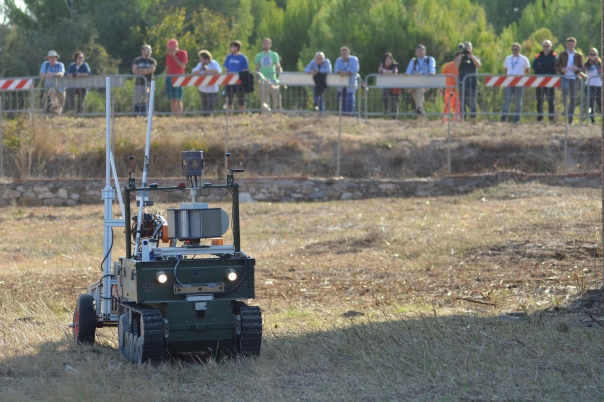Blog Archives
New and notable – further selected publications from the Science Communication Unit
Last week we posted details of our work on environmental policy publications as well as our research on outreach and informal learning. This week’s blog highlights our work in public engagement with robotics and robot ethics, as well as our work on science communication in wider cultural areas, including film, theatre and festivals. We also revisit the controversial issue of ‘fun’ in science communication.
Robot Ethics
Winfield, A. F. (2016) Written evidence submitted to the UK Parliamentary Select Committee on Science and Technology Inquiry on Robotics and Artificial Intelligence. Discussion Paper. Science and Technology Committee (Commons), Website. Available from: http://eprints.uwe.ac.uk/29428
This is a slightly unusual publication; here Professor Alan Winfield tells the story behind it. In March 2016 the UK Parliamentary Select Committee on Science and Technology opened an inquiry on Robotics and Autonomous Systems they posed four questions; the fourth of which held the greatest interest for me: The social, legal and ethical issues raised by developments in robotics and artificial intelligence technologies, and how they should be addressed? Then, in April, I was contacted by the EPSRC RAS UK network and asked if I could draft a response to this question to then form part of their response to the inquiry. This I did, but of course because of the word limit on overall responses, my contribution to the RAS UK submission was, inevitably, very abbreviated. I was also asked by Phil Nelson, CEO of EPSRC, to brief him prior to his oral evidence to the inquiry, which I was happy to do. Following the first oral evidence session I then wrote to the Nicola Blackwood MP, (then) chair of the Select Committee. In response the committee asked if they could publish my full evidence, which of course I was very happy for them to do. My full evidence was published on the committee web pages on 7 June. To compete the story the inquiry published its full report on 13 September 2016, and I was very pleased to find myself quoted in that report. I was equally pleased to see one of my recommendations – that a commission be set up – appear in the recommendations of the final report; of course other evidence made the same recommendation, but I hope my evidence helped!
Our public engagement projects also influence research as this paper by the Eurathlon consortium shows. The paper reports on the advancement of the field of robotics achieved through the Eurathlon competition:
Winfield, A. F., Franco, M. P., Brueggemann, B., Castro, A., Limon, M. C., Ferri, G., Ferreira, F., Liu, X., Petillot, Y., Roning, J., Schneider, F., Stengler, E., Sosa, D. and Viguria, A. (2016) euRathlon 2015: A multi-domain multi-robot grand challenge for search and rescue robots. In: Alboul, L., Damian, D. and Aitken, J. M., eds. (2016) Towards Autonomous Robotic Systems. (9716) Springer, pp. 351-363. Available from: http://eprints.uwe.ac.uk/29283
“Fun” in science communication
The following two publications are the same text published in two different books (with permission). The chapters summarise the views of the authors, including our own Dr Erik Stengler, about the use of fun in science communication, and specifically in science centres.
Viladot, P., Stengler, E. and Fernández, G. (2016) From fun science to seductive science. In: Kiraly, A. and Tel, T., eds. (2016) Teaching Physics Innovatively 2015. ELTE University. ISBN 9789632848150 Available from: http://eprints.uwe.ac.uk/27793
Viladot, P., Stengler, E. and Fernández, G. (2016) From “fun science” to seductive science. In: Franche, C., ed. (2016) Spokes Panorama 2015. ECSITE, pp. 53-65. Available from: http://eprints.uwe.ac.uk/29105
Both of these are related to a rather controversial blogpost hosted on the SCU blog. That post was selected for publication in a book that captures a collection of thought-provoking blog posts from the Museum field all over the world. In it Erik expressed in a more informal and provocative manner the ideas in the above papers.
Stengler, E. (2016) Science communicators need to get it: Science isn’t fun. In: Farnell, G., ed. (2016) The Museums Blog Book. MuseumsEtc. [In Press] Available from: http://eprints.uwe.ac.uk/30360
Science communication through wider cultural activities
A recent commentary explores the factors that contribute to festival goers’ choice to attend science-based events at a summer cultural festival. Presented with a huge variety of interesting cultural events, attendances at science-based events were strong, with high levels of enjoyment and engagement with scientists and other speakers. Our research found out that audiences saw science not as something distinct from “cultural” events but as just another option: Science was culture.
Sardo, A.M. and Grand, A., 2016. “Science in culture: audiences’ perspective on engaging with science at a summer festival”. Science Communication Vol. 38(2) 251–260.
This is a paper on science communication through online videos, long awaited by the small community of researchers working on this specific field who met at the conference above. It reports research conducted by interviewing the people behind the most viewed and relevant UK-based science channels in YouTube. One clear conclusion is that whilst all are aware of the great potential of online video with respect to TV broadcasting, only a few, mainly the BBC, has the insight and the means to realise it in full:
Erviti, M. d. C. and Stengler, E. (2016) Online science videos: An exploratory study with major professional content providers in the United Kingdom. Journal of Science Communication. [In Press] Available from: http://eprints.uwe.ac.uk/30236
One area we are interested in is the impact of cultural events on the audience. In this recent paper, we explore the impact of a performance about haematological stem cell transplant on two key audiences: haematology nursing staff and transplant patients. The article suggests that this type of performance is beneficial to both groups, encouraging nursing staff to think differently about their patients and allowing patients to reflect on their past experience in new ways.
Weitkamp, E and Mermikides, A. (2016). Medical Performance and the ‘Inaccessible’ experience of illness: an Exploratory Study, Medical Humanities, 42:186- 193. http://mh.bmj.com/content/42/3/186 (open access)
We’re also very pleased to highlight a publication arising from a student final year project. This was first presented at an international conference in Budapest. It presents the results of a study of the Physics and Astronomy content of At-Bristol in relation to the national curriculum:
Stengler, E. and Tee, J. (2016) Inspiring pupils to study Physics and Astronomy at the science centre at-Bristol, UK. In: Kiraly, A. and Tel, T., eds. (2016) Teaching Physics Innovatively 2015. ELTE University. ISBN 9789632848150 Available from: http://eprints.uwe.ac.uk/28122
As we are keen to share our learning more widely, we also occasionally report from conferences. This report, published in JCOM, summarizes highlights of the sessions Erik attended at the 15th Annual STS conference in Graz. It focuses on sessions relevant to robotics and on science communication through online videos, the latter being the session where Erik presented a paper (see next item below):
Stengler, E. (2016) 15th annual STS Conference Graz 2016. Journal of Science Communication. ISSN 1824-2049 Available from: http://eprints.uwe.ac.uk/29106
We hope that you find our work interesting and insightful – details of all our publications to date can be found on the Science Communication Unit webpages.
The story behind the cameras: filming robots
In 2013, just as I was finishing my Masters in Science Communication at UWE Bristol, I was asked to help film the euRathlon robotics competition in Germany. euRathlon was inspired by the situation that officials were faced with after the nuclear accident in Fukushima in 2011. The competition challenges robotics engineers to solve the problems of dealing with an emergency scenario, pushing innovation and creativity in the robotics domain. The project is led by Prof. Alan Winfield from UWE alongside seven other partner institutions. The 2015 euRathlon competition in Piombino, Italy combined land, sea and air challenges for the robots to overcome. Our 2015 film team included three of us (Josh Hayes Davidson on graphics, Charlie Nevett on camera and myself – Tim Moxon – as producer and sound engineer), taking with us all the lessons I learned from 2013.
Filming robots, particularly complex robots designed to respond to emergency scenarios, is a daunting task. Trying to make sure that we didn’t get too technical was always going to be a problem. We had the additional issue that English was not the first language of most of the people being interviewed which really added to the challenge. Taking care and with plenty of re-shoots we managed to get round both of the problems by sticking to the golden rules: take it slow and keep it simple. This made sure that we never lost sight of what we were trying to do. Our focus was always to bring 21st century robotics into the public eye.
The first two days of the competition presented the individual land, sea and air trials. On site we first created two “meet the teams” films where we interviewed all 16 teams and got to know them. Luckily they were all super friendly and very cooperative which meant we got all the teams interviewed in two days. After that the real work began. The land trials were easy enough to film and get a good story line of shots as the robots were almost always visible. However the underwater robots required a bit more imagination. In the end a GoPro on a piece of drift wood got us the shots we needed.
The aerial robots had some issues too as getting long distance shots was not always easy. Fortunately Josh and Charlie were more than up to the task.
Day 3 and 4 focused on combining two domains, so land and sea or air and land etc. Day 3 went well with fantastic interviews with judges and teams helping to really give some depth to the videos. Again underwater proved to be a bit challenging but we managed, with the help of some footage given to us by the teams that they took on-board their robots. Day 4 didn’t go as well as the second half of the competition had to be cancelled due to strong winds. Wind had been an issue throughout the competition and all of our equipment required regular cleaning to keep the dust out, as well as dealing with constant wind when recording sound.
That day however you could barely stand in the open for all the dust and sand being kicked up by the wind and getting good sound for interviews was nearly impossible. We could only hope that the weather improved for the Grand Challenge.
The final days were the Grand Challenge, as much for us filming as for those competing. The timescale was starting to tighten as we only had two days to film, cut and polish the remaining two videos. With increasing pressure to produce high quality products we pulled out all the stops. Fortunately all the teams rose to the occasion and provided us with some spectacular on-board footage as well as some nice underwater diver footage. The Grand Challenge turned out to be a great success with all the teams at least competing even if they didn’t all finish the challenge.
Tim Moxon completed the UWE Bristol Masters in Science Communication in 2013.
For more information about EuRathlon please visit the project website.


